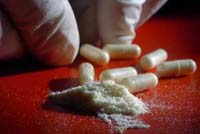 Molly is the street name for a drug that is pushed as the pure powder form of a banned substance known as MDMA, the main chemical in ecstasy. In the last five years, Molly has made its way into popular culture, helped by references to it made by various entertainers.
Molly is the street name for a drug that is pushed as the pure powder form of a banned substance known as MDMA, the main chemical in ecstasy. In the last five years, Molly has made its way into popular culture, helped by references to it made by various entertainers.
If you’re in your twenties and frequent music events such as raves — you have more than likely encountered the drug. While ecstasy was popular in underground nightclub raves in the nineties, molly has become the drug of choice for millennials. Every generation is characterized by one drug or another: the sixties and seventies with pot and hallucinogenics, the eighties with cocaine, and so on.
The Drug Enforcement Administration (DEA) considers MDMA to be a Schedule I controlled substance, which means it has a high potential for abuse, and no accepted use in medical treatment. The DEA notes that MDMA can cause confusion, anxiety, depression, paranoia, sleep problems, and drug craving.
The drug also can cause muscle tension, tremors, involuntary teeth clenching, muscle cramps, nausea, faintness, chills, sweating, and blurred vision. High doses of it can interfere with the ability to regulate body temperature, resulting in a sharp increase in body temperature (hyperthermia), leading to liver, kidney and cardiovascular failure. Severe dehydration can result from the combination of the drug’s effects and the crowded and hot conditions in which the drug is often taken.
It appears that the Molly drug usually comes from labs in China so everyone should be aware that the product could be mixed with other chemicals or substances — such as caffeine, amphetamines, PCP, or cocaine. Its purity is always in question.
Do you have a drug abuse problem? The solution: street drugs alternative
0 responses so far ↓
There are no comments yet...Kick things off by filling out the form below.
Leave a Comment